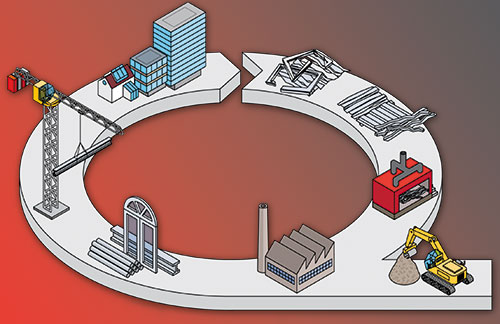The CO2 content of structural steel
 To calculate the environmental impacts of steel manufacturing, the World Steel Association adopts the ‘system expansion’ method of life cycle assessment, which is the preferred approach of the ISO 14040 series of environmental standards. This approach considers all new steel to be part of a single global system of supply and demand. Credits are given for co-products used in the manufacturing process which save energy or emissions, such as process gases being used to generate electricity. An example of the calculation method for the carbon dioxide emissions associated with steel production can be viewed at www.corusconstruction.com
To calculate the environmental impacts of steel manufacturing, the World Steel Association adopts the ‘system expansion’ method of life cycle assessment, which is the preferred approach of the ISO 14040 series of environmental standards. This approach considers all new steel to be part of a single global system of supply and demand. Credits are given for co-products used in the manufacturing process which save energy or emissions, such as process gases being used to generate electricity. An example of the calculation method for the carbon dioxide emissions associated with steel production can be viewed at www.corusconstruction.com
Carbon and energy impacts of steel products:

It is standard practice to express these figures on a per tonne basis. This may give the impression that steel has higher impacts than other construction products. However, steel has a higher strength-to-weight ratio than most other structural materials meaning that one tonne of steel goes a lot further. As a result, the CO2 emissions associated with any steel building will be lower.
Cradle-to-gate-values
There are other values in circulation for the carbon content of steel. Some are higher and some are lower than the values in the table opposite. Most other values have been derived by less rigorous methods than system expansion. These other methods generally rely on a cradle-to-gate analysis and thus ignore the environmentally beneficial effect of recycling, which only becomes apparent during the full cradle-to-grave life cycle. Inferior cradle-to-gate methods are used for comparison because other material industries cannot provide robust cradle-to-grave data to the level of the steel industry.



